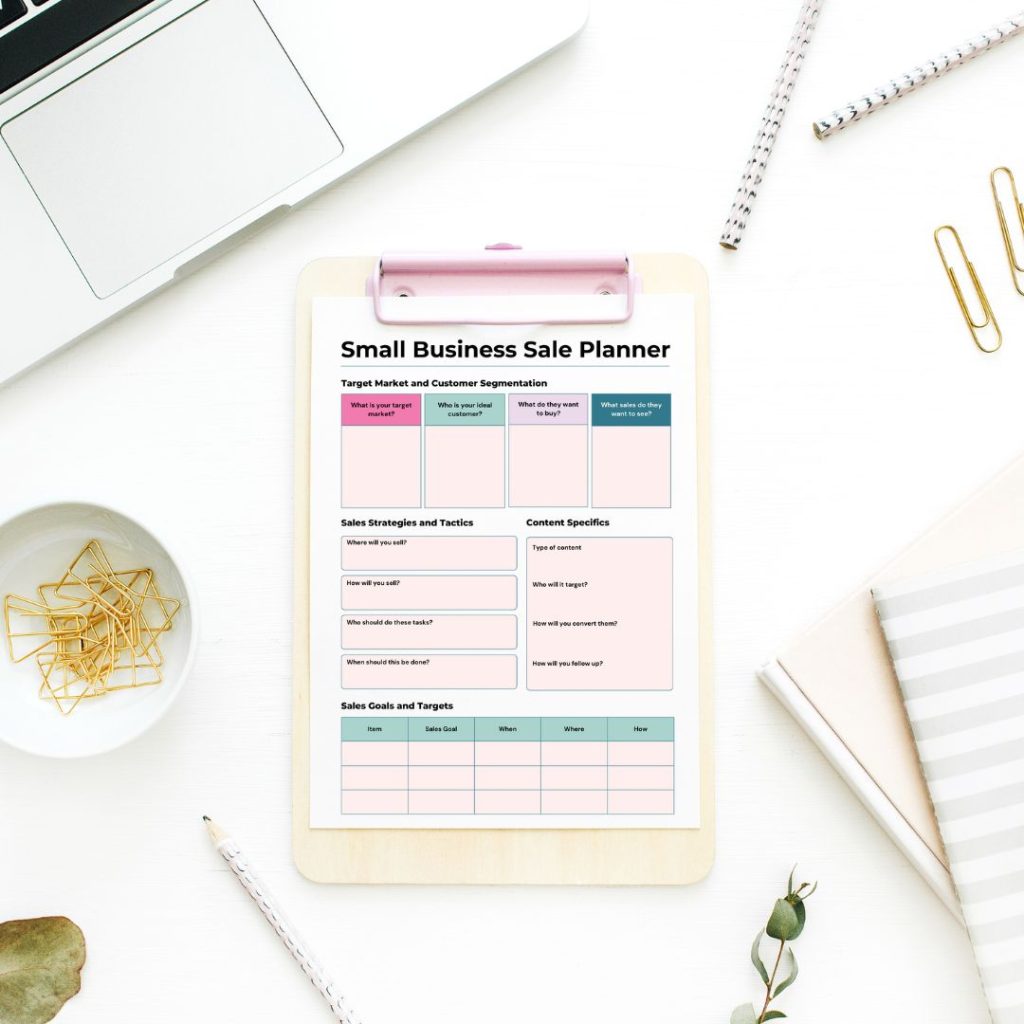Today I'm going to talk to you about setting goals and why they're important for your small business. From the Pareto Principle to the SMART Goals Framework, I'm going to teach you my best goal setting tips to help you crush your craft business goals this year.
If you're looking to start a craft business this year, make sure you check out my 5 Things You Should Know Before You Start a Craft Business post.

If you'd like more specific tips and to hear more about specific goals Cori and I are setting, you can watch us talk through this topic by pressing play on the video below.
Why is Setting Goals Important?
Setting goals is important because they help us prepare for the year, help us avoid burnout, allow us to stay flexible, and can help us boost profitability.
Prepare for the Year
It's important to look at the entire year when setting goals. We want to be aware of what is coming up. By setting goals with the whole year in mind, we can make adjustments based on how busy the schedule is.
Avoid Burnout
When setting goals and planning out the year in advance, it's important to schedule in rest and relaxation. I put a reminder in my phone on the 1st of every month to schedule in rest time. This helps ensure I am ready to work when I need to, and not completely overwhelmed and exhausted.
Stay Flexible
Another reason to plan out the year is that it allows you to be flexible. If you know what is coming up, you can adjust your schedule based on what your workload looks like.
Boost Profitability
If you set goals and then review them regularly, it can help boost profitability. You can stay on task and course correct as the year goes on instead of being swayed by trends.

Get my free small business sale planner!
Plan your next sale using this 2 page planner and reach as many people as possible! Increase your reach and increase your sales with a well thought out plan that will have customer coming back again and again!
What is the Pareto Principle?
The Pareto Principle states that 20% of the work you're doing in your business drives 80% of the results.
Use data, don't make guesses. Look at the numbers and see what you're doing that is moving the needle.
One way to do this is to write down everything that you do. From social media to sending emails, everything takes time. Are you using your time wisely?
When looking at the things you're doing, note whether or not it is currently working for you. There may be items that are not working right now, but could be if you had more time to do them. You may need to cut out something else to make more time to do the things that move the needle.
For instance, a few years ago I realized my sublimation content was doing better than other content. In order to have time to do more with sublimation, I had to cut out some of the other things I was doing. Because sublimation was rather new, there wasn't a lot of competition. This worked well for me.
Do be aware of putting all your eggs in one basket. You need to be prepared if something goes away. TikTok is a good example, it could go away any time, and anyone who based their entire business on that platform may have a hard time recovering if they don't have another way to contact their subscribers.

The SMART Goals Framework
Now that you have an idea of what you may want to focus on this year, let's talk about the SMART Goals Framework.
- S – specific
- M – measurable
- A – achievable
- R – relevant
- T – timebound
To make sure your craft business goals are SMART, keep the following in mind when setting them:
- Goals need to be specific. They should be clear goals that provide focus and direction throughout the year.
- Goals should be measurable. Numbers alone don't mean anything if you don't know what they're helping you measure. Goals should motivate you. Find the things that motivate you when setting goals. You may need to reframe the goal in a way that motivates you vs. what everyone else is doing.
- Your goals should be achievable. Yes, you want to grow and you want to have to reach for your goals, but setting unattainable goals does not motivate. It's unlikely you will grow your social media following by 1,000,000 followers this year, setting that goal and not reaching it is unlikely to inspire you to work toward it. Look closely at your goals and make sure you're being reasonable. Celebrate when you reach a goal, even a small goal.
- Another thing to keep in mind is that your goals should be relevant to your business. Having a goal that you want to read 100 books this year may be a great goal to have, but it won't impact your business unless your business is all about books.
- Goals should be timebound. Throwing a goal onto a paper without adding a timeframe to it creates no urgency to get it done. Look at your goals, how can you break them up over the year to help you stay on task? For example, if you have a goal to grow your social media following by 1,200 people this year, it may be helpful to break that up by month to help you stay on task and remind yourself to check in.
Use this mindset and your list of things you do to come up with goals that will work for you and your business

Craft your future by turning your passion into a paycheck! With more than 25 years experience and a DIY community of more than 1.5 million, Angie Holden and Cori George share handmade business strategies, craft business insights, and inspirational stories. Every other Monday, you’ll learn from experts how to use your crafts to financially support a creative life.
Click here to sign up so you don't miss future episodes of Crafting for Profit Live!
Adding a Timeline to Your Goals for the Year
Now that you have some craft business goals in mind, you want to make sure you stay on task all year and hit those goals!
Build a Calendar
The first thing I do is build a calendar. The type of calendar does not matter as long as it's a calendar you'll use.
Write down all major events for the year. These can include vacations, craft fairs, and other life events.
One example is that tax season sneaks up on me every year. I have to do taxes every year, but I don't plan for the time it will take me to prepare them. When I'm not prepared for the extra time I spend on taxes, I can get behind on my goals.
Another example is football season. My son played football for years and I often didn't take into account the extra time I'd be spending in the evenings and weekends doing football things.
Spread Goals Throughout the Year
With a calendar that has the entire year mapped out, I can make sure I'm prepared for those busier times by doing extra work during times that I'm less busy.
I like to use Quarters 1 and 2 to prepare for my busier months in Quarters 3 & 4. I am less busy with life and work at the beginning of the year, and by using that time to map out the entire year and put routines in place, I am setting myself up for success.
When possible, I like to use slower times to create content that can be used later in the year so I don't have to worry when life and business are crazy. You can do this by prepping holiday specific content early in the year or have a backlog of evergreen content that is always available when things get busy.
When setting goals, make sure you keep the entire year in mind. If you only set goals for each month or quarter, you may find yourself scrambling when your busy seasons arrive.
I hope these tips have helped you look at goal setting in a way that will allow you to be productive all year long. If you have any additional questions, feel free to leave them in the comments and I'll be happy to answer them for you.












